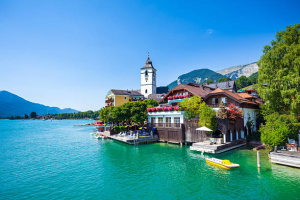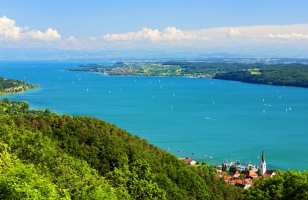Top 5 Most Beautiful Lakes in Zambia
Despite being a landlocked country, Zambia may be among the nations with the greatest abundance of water resources. And the country's enormous and stunning ... read more...lakes are just as breathtaking as Victoria Falls and the powerful Zambezi River. While Lake Kariba is Africa's largest man-made dam and is quickly developing into Zambia's very own French Riviera, Lake Tanganyika is the longest lake in the world. The tropical and untamed Lake Mweru offers a wonderful picture of village life that stretches along the banks of this enormous lake in the far north to the more adventurous traveler. They are great lakes to visit in Zambia overall.
-
Zambia's Lake Kariba is home to breathtaking landscapes, breathtaking sunsets, fantastic fishing, boating, and water sports options, as well as beautiful peaceful vacations or weekends spent simply soaking up the sun. Most days are sunny and pleasant here. Midsummer can be quite warm, but even midwinter has pleasant days and cool nights.
Lake Kariba is Africa's largest man-made dam, measuring 226 kilometers long and up to 40 kilometers wide in parts. It generates a significant amount of electricity for both Zambia and Zimbabwe and supports a robust commercial fishing industry. The sheer vastness of it makes one forget it's a dam, and it almost feels like an ocean in certain areas! Any trip to Kariba or Siavonga should involve a stop at the Dam Wall if only to marvel at the enormity of this magnificent construction. At the bridge's entrance, there is a display that describes the construction of the wall and the statistics involved. The wide bridge allows for plenty of walking space on both sides. The striking contrast between the endless lake on one side and the precipitous drop into the valley on the other is amazing.
One of the popular activities on Lake Karibu is fishing. The annual Tiger Fishing Competition is held in May further down the lake's shore at Sinazongwe and draws fishermen from all over the subcontinent. The tiger fish, which is widely regarded as one of the best game fish available, has thrived in the lake's nutrient-rich waters. The maximum average weight caught in competition is slightly under eight pounds, but the tigerfish is a fair opponent for the skilled angler because of its speed, bravery, and strength.
Kapenta, a little sardine-like fish, has been introduced to Kariba with great success. In 1967, the Shoals were transported from Lake Tanganyika to Lake Kariba. Kapenta is also dried and distributed as a high-protein dietary supplement in locations where fish is scarce.
Location: Central Africa, between Zambia and Zimbabwe

Overseas Adventure Travel Jamie White's Channel -
When looking out over Lake Bangweulu, the waters are a grayish blue and mix seamlessly with the sky in the distance. The exact location of the horizon is unclear. "The Place Where the Water Meets the Sky" is what "Bangweulu" means.
More so than for its potential as a tourist destination, the Lake is used as a fish supply. This is terrible because it has magnificent beauty. There are rumors of plans to build a resort for tourists and offer a high-end cruise boat for hire. But for the time being, this makes for an interesting pit stop for the adventurous traveler by car or backpacker.
Cychlids (bream, tigerfish, yellow belly) and catfish are the most common catches in Lake Bangweulu. Each year, around 57 000 metric tons of fish are collected from the Lake. Although fish stocks are not in jeopardy, catches are decreasing and the preferred species are getting scarce.
The Bangweulu fisheries are among the largest in Zambia. This has resulted in some of the highest population densities surrounding the Lake, particularly in areas where professional fishermen have concentrated. Nonetheless, the fishing sector is not commercially developed, and insufficient regulations and marketing facilities jeopardize the business's overall sustainability and profitability. Many of the fishermen use a barter system to exchange their catches for necessities.The main town on the lake, Samfya, began as a little fishing community in the middle of the 20th century. Fresh seafood and essential necessities are both available. There is a post office, a hospital, and enough fuel.
Location: Zambia's Luapula Province and Northern Province

Lake Bangweulu (Samfya) - TripAdvisor 
The Speech Analyst's Facebook -
Lake Mweru is one of the most beautiful lakes in Zambia. This stunning lake is located on Zambia's extreme northwestern border and is shared more or less evenly with Zaire/DRC. The Luapula River enters from the south, forming the official border between northern Zambia and Zaire. It also drains from the northern lake. From the east comes the Kalungwishi River. Both river mouths generate significant deltas that are major fish breeding sites.
Until the arrival of the tar road in Nchelenge in 1987, there were just a few settlements scattered around the lake. However, as people started to benefit from the bounty of the lake, the population grew. Animals that weren't poached migrated away to more peaceful locations as the once-wild area became peri-urban. Thousands of people now reside on the beaches of this vast body of water, which also serves as a source of food and a means of subsistence.
Lake Mweru, despite being off the usual path, is worth a visit. The lake has produced a vibrant populace that is rich in culture, passionate about trade, and colorful in nature. The place is almost a microcosm of what Tropical Africa could become if left alone.
Tourist amenities, on the other hand, are restricted to a few 'guesthouses' of various qualities. The temperature of the water ranges from 21℃ to 29℃. Temperatures in the air range from 27.5℃ to 35℃. The lake is chemically very fruitful and contributes significantly to Zambia's fishing economy.
The lake, which is located on the outskirts of Mweru Wantipa National Park, is only known to a small number of tourists. Although poaching has nearly completely wiped off the once-thriving crocodile and elephant populations that were once located within the National Park, the area is still a fantastic site to watch different waterbirds and a good place to camp. The Luapula River, which feeds the lake, has a number of beautiful waterfalls, and the numerous tiny villages you pass through add to the journey's charm.
With the exception of the occasional pothole, the road south from the lake is a decent tar road all the way back to Ndola, and the gravel road leading northeast toward Lake Tanganyika is likewise fairly comfortable.
Location: Central Africa, bordered to the east by Zambia and to the west by Congo (Kinshasa)
Zambia Travel Agency 
Wikimedia Commons -
The English explorers Richard Burton and John Speke first introduced this immense inland sea to the rest of Europe in the middle of the nineteenth century. When they reached its shores in February 1858 after searching for it as the Nile's origin, they learned that the Ruzizi River in the north, which they believed to be the Nile, actually flowed into the lake rather than out of it. (The film "Mountains of the Moon" chronicles their extraordinary trek.)
Tanganyika's waters border Tanzania, Burundi, the Democratic Republic of the Congo, and Zambia. It is the world's longest freshwater lake and the second deepest, behind Lake Baikal in Russia. The Great Rift Valley, which also formed the steep shoreline, is responsible for the tremendous depth. It has a depth of 1433 meters (4 700 feet), which is 642 meters below sea level. Although Zambia only claims 7% of its land area, it stretches 677 kilometers (420 miles) from north to south and is around fifty kilometers broad on average (31 miles). The pristine waters are home to over 350 different fish species and are widely known for aquarium fish exports and superb angling.
Lake Tanganyika is home to around 350 fish species, the majority of which are indigenous. Lake Tanganyika, like Lake Malawi, is exceedingly old, and the combination of its age and ecological isolation has resulted in the formation of distinct fish populations. Because new species are constantly discovered in these remarkable lakes, it is difficult to say which has the greatest diversity, but they do share the distinction of being the top two lakes in the world in terms of biodiversity, with Lake Tanganyika having the highest proportion of endemicity, concentrated primarily in the lake's Zambian waters.
To ensure that its biological richness is preserved, the Lake Tanganyika Biodiversity Project was established. The project's goal is to create a manageable and long-lasting system for protecting and preserving Lake Tanganyika's biodiversity.
Lake Tanganyika, considered one of the most biologically diverse environments on the planet, is also an evolutionary showcase due to its antiquity and stability. Tanganyika is home to 98% of the lake's cychlids (which account for two-thirds of the lake's fish). All seven crabs, five of the thirteen bivalve molluscs, more than half of the gastropod molluscs, and eleven of the thirty-three copepod crustaceans are also endemic.
The goliath tigerfish and Nile perch are among the fish that can be caught while sport fishing here. Except for the area around Mpulungu, most of the shoreline is inhabited by crocodiles, perhaps as a result of the noise made by people and motorboats. It is a true joy to swim in the lake (only in the Mpulungu area!). Warm, clean, salt-free water that occasionally shifts abruptly from smooth stillness to strong waves for excellent body surfing. The calm waters in the south are probably stirred up by storms from way up north.
Location: Within the Albertine Rift, the western branch of the East African Rift
Lake Tanganyika - Zambia Tourism 
Peapix -
A "gigantic sink hole" and difficult scuba diving location is Lake Kashiba. Its existence is surrounded by numerous ethereal tales and legends. The lake is special, unspoiled, and tranquil. It is situated in a wild, untamed area. On Zambia's Copperbelt, this stunning and breathtaking lake offers a natural vacation destination to both tourists and the local populace.
Lake Kashiba is located southwest of the Mpongwe District in the Copperbelt Province. More than three-quarters of the way there is an asphalt road leading there, and the remaining distance is an all-weather laterite road.
A variety of fish species live in the lake, and numerous birds live in the neighboring mushitu forest. The lake's attractiveness is enhanced further by the blueish tint of the water, which gives it the appearance of a massive natural swimming pool with no visible river entering or leaving it.
The lake's physical layout is unusual. It has a rectangular shape and is surrounded by towering vertical cliffs. The water line is lower than the ground surface around it. The sunken lake is the product of karst topography created by limestone weathering.
The lake has been around for millions of years. It happens as a result of seepage dissolving the limestone bedrock beneath the earth through a chemical reaction involving the carbonation of calcium carbonate in limestone by diluted carbonic acid. The lake is relatively deep, and only a slight rise in water level occurs during the height of the rainy season.
It has a length of 800 meters and a depth of 100 meters on all sides. The lake's depth in the middle, however, is uncertain. Lake Kashiba is the ultimate scuba diving challenge because of this. A true underwater "nightmare." Scuba divers who want to determine the lake's depth frequently visit the lake.
Location: South-west of Luanshya in Zambia, close to Mpongwe and St Anthony's Mission

TRY Zambia Travel and Tours's Facebook 
TRY Zambia Travel and Tours's Facebook


























